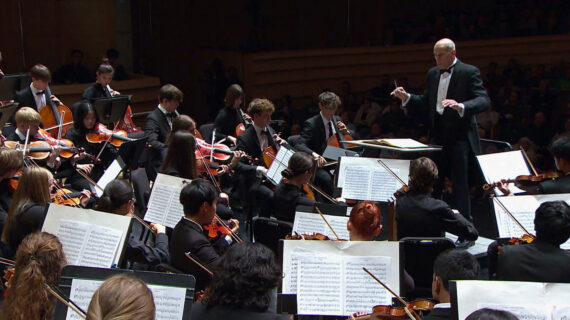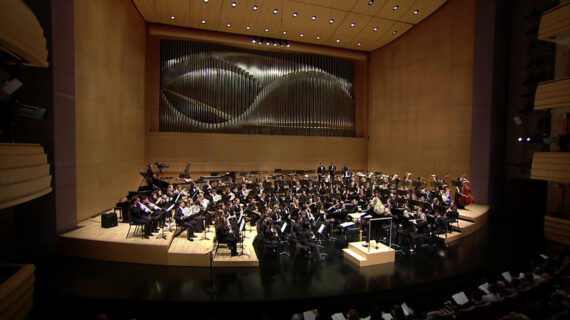Frederica Freyberg:
Our next guest appeared on behalf of the complainant in Mukwonago in the formal hearing against the district, and works to rid schools across the state of Indian mascots, logos and nicknames as part of the Wisconsin Indian Education Association. Barbara Munson joins us. Thanks very much for doing so.
Barbara Munson:
Thank you, Frederica.
Frederica Freyberg:
What was your reaction to the Mukwonago School District’s refusal to comply with the DPI order to get rid of their Indian logo and nickname?
Barbara Munson:
I was disappointed on a number of levels. I’m always hoping that Mukwonago will do the right thing in terms of the issue of stereotyping in the schools. And stop thinking about trying to hold onto– trying to hold onto a symbol, for its sports teams primarily, that is a race-based symbol of an American Indian male in feathered head dress. This is, in and of itself, it’s a stereotype. Yeah.
Frederica Freyberg:
And the complainant, the young man who had recently graduated, had he felt he suffered from stereotyping or harassment as a result of this nickname and logo in his high school?
Barbara Munson:
He did indeed. As have other complainants under the old law. One of the things that I keep hearing from the Mukwonago area that is really inaccurate is that a single complainant can cause change. Under all discrimination law, whether it’s state or national, a single complainant can create change if a judgment is made against them. There is nothing unusual about that at all in regards to this law.
Frederica Freyberg:
How do these kinds of logos, though, promote stereotyping or harassment?
Barbara Munson:
Okay. First and foremost, that plains Indian warrior in feathered head dress is a stereotype in and of itself. It's used It's probably the most common Indian logo that is used in the nation. And it gives a one dimensional viewpoint of native people. The tribes in the state of Wisconsin are not plains Indian tribes. We are all woodland Indian people. There are 565 federally recognized American Indian tribal groups. That particular image limits us and brings us down to a stereotype, and it has sort of a time– a feeling of time to it as well. It puts it firmly in the past.
Frederica Freyberg:
And so, because it's kind of used interchangeably, this one image of a plains Indian which isn’t representative of Indians native to Wisconsin, it's that piece that is offensive?
Barbara Munson:
Well, that is certainly a part of what we’re talking about, but we don’t use the word offensive when we’re dealing with this issue, because we are talking about a form of stereotyping. We are talking about the pupil non-discrimination laws. We’re talking about discrimination. Whether or not one of us is offended is not the point. The point is that there is a body of research that clearly shows that Indian race-based stereotypes harm native students, and that is discrimination.
Frederica Freyberg:
How many districts in Wisconsin have gotten rid of these kinds of logos or mascots, and then, alternately, how many still exist?
Barbara Munson:
With Winter School District and the Berlin School District, which is in the process of changing, there will be 35 school districts that have changed an Indian mascot and logo. With Mukwonago still holding out there are 30 that retain Indian mascots and logos. It is sometimes hard for communities that have defended a logo for a long time to even recognize that the image that they are defending is a stereotype. And that is part of the problem.
Frederica Freyberg:
Is there ever a time when such a logo is okay?
Barbara Munson:
Some would say that if a native tribe used a mascot or logo it would be okay, because they might be able to teach things from their culture. That would be so if it weren’t for the fact that school districts– Local control really doesn’t work on this issue, because our school districts interact with one another in interscholastic play so a single Indian mascot logo depiction impacts all of the school districts throughout the state. And even a school district that has gone through a careful process and made the change in order to protect, the native and non-native students alike, from race-based stereotyping is Those students are exposed to the Indian mascot when they play in interscholastic competition.
Frederica Freyberg:
We need to leave it there. Barbara Munson, thanks very much for your insight on this.
Barbara Munson:
Thank you very much.
Search Episodes
Related Stories from PBS Wisconsin's Blog

Donate to sign up. Activate and sign in to Passport. It's that easy to help PBS Wisconsin serve your community through media that educates, inspires, and entertains.
Make your membership gift today
Only for new users: Activate Passport using your code or email address
Already a member?
Look up my account
Need some help? Go to FAQ or visit PBS Passport Help
Need help accessing PBS Wisconsin anywhere?

Online Access | Platform & Device Access | Cable or Satellite Access | Over-The-Air Access
Visit Access Guide
Need help accessing PBS Wisconsin anywhere?

Visit Our
Live TV Access Guide
Online AccessPlatform & Device Access
Cable or Satellite Access
Over-The-Air Access
Visit Access Guide
 Passport
Passport








Follow Us